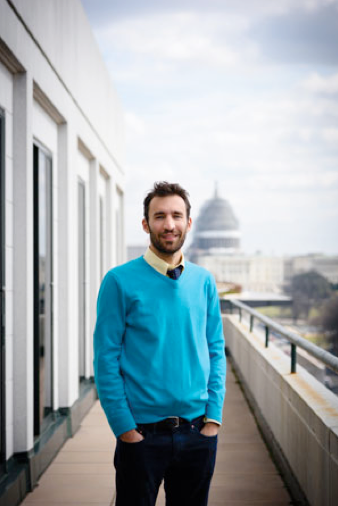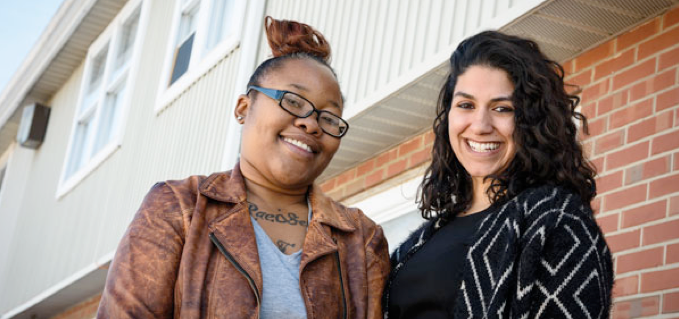Original published on Apr 01, 2016 04:40 am CDT by Lorelei Laird in the American Bar Association e-journal

Zina Makar [Photo by David Hills]
But on Oct. 24 of last year, Wise, 26, had a fight with her younger sister, who has mental disabilities. The next day, Wise dropped off her kids, ages 2 and 5, at day care and school. When she got home, she found the police waiting with a warrant for her arrest. Her sister had filed a false police report against her for assault.
A judge set bail at $35,000, which was increased to $100,000 at a bail review hearing because—based on the allegations against her—the judge believed Wise was dangerous.
Wise didn’t have that kind of money. Her family scraped together a down payment to a bail bond company, but it took five days. During that time, her kids had to be shuttled between their father and another of her sisters.
Worse yet, Wise missed work and fell behind on bills. The Maryland Public Service Commission, which regulates her driving job, sent her two scary letters requesting information on the outcome of her charges. Her grades suffered, and she had to postpone an externship in medical billing—a step toward her planned career—because it conflicted with a court date.
Zina Makar, an Open Society Institute fellow working in partnership with the Maryland Office of the Public Defender, represented Wise in order to secure her release from pretrial custody. After her release, the charges against Wise were ultimately dismissed. But that didn’t happen until Jan. 8—the first day a court gave Wise’s case meaningful review since a Nov. 19 postponement. If Wise hadn’t been bailed out, she could have been in jail for more than two months. As it was, five days were enough to set her back.

Shannan Wise relied on relatives to care for her children while she was jailed for five days. [Photo by David Hills]
Wise says it was stressful. “It just put a lot of strain on me, a lot of strain on bills, when it was already a trying time,” she says. “I’ve been doing things to keep myself out of trouble no matter what, and I ended up in a real bad situation that could have ended even worse than what it was.”
REFORM MOVEMENT
Stories like Wise’s illustrate why court systems are rethinking the use of financial bail. Concerned about the chain of negative effects bail can have on people of modest means, as well as its contribution to jail overcrowding and costs, jurisdictions around the nation are reforming bail. In 2013, Kentucky was among the earliest to adopt a pretrial system replacing cash bond with risk assessments and pretrial supervision. In 2014, New Jersey voters agreed to a similar system.
Last summer, New York City announced it was replacing money bond for low-risk defendants with text reminders to appear in court and counseling as appropriate. The state’s chief judge, Jonathan Lippman, announced in October that New York would encourage judges to use alternatives to financial bond. In Texas, Chief Justice Nathan Hecht formed a committee in June to study whether financial bond can be replaced with an evidence-based screening process.
Even the U.S. Department of Justice has come out strongly against the use of financial bail. Last year, the department intervened in a little-noticed lawsuit challenging bail practices in Clanton, Alabama. “It is the position of the United States that [financial bond, set] without any regard for indigence, not only violates the 14th Amendment’s equal protection clause but also constitutes bad public policy,” the department wrote, intervening in a lawsuit filed by the nonprofit Equal Justice Under Law.
Advocates for the poor have long argued that financial bond is neither fair nor safe. By conditioning freedom on the ability to pay, they say, bail systems needlessly imprison poor defendants who pose no threat. Meanwhile, wealthy people go free regardless of what danger they might pose. Fifty years ago, those arguments led Congress to pass the Bail Reform Act of 1966, which eliminated financial bond for most federal defendants. But over the next few decades, the issue fell out of the public eye.
Now, the issue is once again being discussed, fueled by increasing bipartisan agreement and interest from the DOJ. This time, local jurisdictions are exploring—voluntarily or otherwise—alternatives to financial bail.
“These things are happening all around the country for various reasons,” says Arthur Pepin, director of New Mexico’s Administrative Office of the Courts and the author of a 2012 paper on evidence-based pretrial release. “Some as a result of litigation,” he says, “some as a result of folks just thinking we should do a better job on this.”
PRICE OF FREEDOM
Financial bond—technically, “bail” refers to all conditions of release—is widespread and routine in state and local jurisdictions. Most use either a judge’s discretion or a bail schedule—a long list of charges corresponding to set prices, based on the severity of the crime. So usually, pretrial freedom comes at a literal price.
“Most of the country is doing it in an old-fashioned, nonscientific way,” says Cherise Fanno Burdeen, executive director of the Pretrial Justice Institute in Gaithersburg, Maryland, and co-chair of the ABA Criminal Justice Section’s Pretrial Justice Committee.
Critics see two major problems with financial bond. One is about the potential public safety threat created by letting wealthier people go free even if they could be dangerous. That’s why law enforcement officers don’t like financial bond, according to Alec Karakatsanis, a co-founder of Equal Justice Under Law and one of Burdeen’s co-chairs on the CJS Pretrial Justice Committee.
Then there’s the opposite problem—locking up people who can’t pay, even if they’re not a threat. There’s evidence that may be a civil rights violation. In a 1978 bail case, Pugh v. Rainwater, the 5th U.S. Circuit Court of Appeals at New Orleans found that without “meaningful consideration of other possible alternatives,” jailing people because they cannot afford bail violates their due process and equal protection rights. The U.S. Supreme Court decided in 1983’s Bearden v. Georgia, a case about payment of fines, that the 14th Amendment forbids “punishing a person for his poverty.”
Imprisonment has far-reaching effects on the defendant’s life, as Wise discovered. Worried about their families, jobs, finances and more, some defendants choose to plead guilty even when they aren’t—despite the well-known stigmas of a conviction.
Chesa Boudin, a deputy public defender in San Francisco, encounters this routinely. “What we see literally every day is judges and prosecutors offer our clients ‘credit for time served’ plea deals,” Boudin says. “If you plead guilty, you get out of jail today. If you assert your innocence, you’re staying in jail. To see that sort of coercive pressure exerted on people to waive their constitutional rights because they’re too poor to pay for their freedom is unbelievably frustrating.”

“Most of the country is doing [financial bond] in an old-fashioned, nonscientific way.” —Cherise Fanno Burdeen [Photo by David Hills]
Another 2013 study by the foundation determined that those held in pretrial detention were more likely to receive prison sentences. The reason: Juries tend to believe that defendants in prison uniforms are guilty, and prosecutors have greater leverage in making plea deals with defendants who are jailed, according to other research.
Detaining those who can’t afford bail also strains jail systems. The Department of Justice estimates that local jail populations grew by 19.8 percent between 2000 and 2014; pretrial detainees accounted for 95 percent of that growth. In mid-2014, the department says, 60 percent of those held in local jails were pretrial detainees.
And that’s expensive. In Philadelphia, the cost of incarceration in the city’s jail system is $110 to $120 per inmate per day. A 2015 Vera Institute of Justice report noted that Bernalillo County, New Mexico, where Albuquerque is located, spends $85.63 per inmate per day. Johnson County, Kansas, where fewer people are incarcerated, reported spending $191.95 per inmate per day.
All of this will be part of the pitch if Burdeen and Karakatsanis, as co-chairs of the Pretrial Justice Committee, introduce a resolution in the ABA’s House of Delegates calling for the abolition of all money-based pretrial detention. The resolution, planned for the 2016 annual meeting this August, would also call for the elimination of private, fee-based pretrial services—a related practice that’s also been the focus of recent litigation.
JAIL ALTERNATIVES
In making that case, they can point to a well-established alternative: pretrial risk assessment, followed by pretrial services that ensure defendants show up to court. That’s the system in use by the federal courts since the 1960s.
Risk assessment includes a series of questions based on research into why people fail to appear. The questions typically examine the defendant’s criminal history, current charge and personal circumstances. The federal questionnaire, for instance, asks about the seriousness of the defendant’s charges, whether he or she has failed to appear in the past, homeownership and employment status, and any strong ties to a foreign country.
Judges consider the answers when making pretrial release decisions. If the offender is deemed dangerous or likely to flee, the system typically requires a preventive detention hearing. Those released get pretrial supervision—regular check-ins with an agent, backed up when necessary by measures such as telephone reminders for court dates, drug treatment and ankle monitors.
Typically, this is much cheaper than detention. In the federal system, the cost of pretrial services was $8.98 per person per day in fiscal 2014, while the cost of pretrial detention was $76.25.
The ABA Criminal Justice Standard 10-1.10 calls on every jurisdiction to use risk assessment and pretrial supervision, making money bond a last resort. Most states have adopted that standard, Burdeen says. But bail is still widespread because it’s easy for judges, she says. “The practice has become that they skip over all these other considerations and options and they just go straight to setting money,” she says. “Because it is a legal option and it’s a shortcut.”
Anne Milgram, former vice president of criminal justice at the Arnold Foundation, adds that cost has also been a deterrent to reforms. Plenty of jurisdictions have looked into Washington, D.C.’s decades-old risk-assessment system, she says—but most decided they couldn’t afford it. The problem is that older risk assessments use interviews with the defendant, which requires a court employee’s time. It also invites the possibility that the defendant will lie or refuse to cooperate.

“I was … watching people stuck in jail because they couldn’t pay $200 bail. … if anything, the principle is even stronger in the pretrial context. You haven’t been convicted of anything yet.” — Alec Karakatsanis [Photo by David Hills]
Interviews take time, which can be a problem if the goal is to get release-eligible defendants freed quickly, he says. Clayton believes financial bail should remain. For one thing, he says, financial bail gives family members, who often stand to lose money or property, an incentive to prevent the defendant from fleeing.
It’s also effective, Clayton says. He cites a 2004 study from the Journal of Law and Economics that concluded defendants who used a bail bond company were 28 percent less likely to fail to appear than those released on their own recognizance. The probability of becoming a fugitive was also 64 percent lower for those using a bail bond company than those paying the court directly. The study attributed this to the work of bond dealers and bounty hunters, who have a financial stake in the outcome and the right to forcibly arrest defendants.
GAINING TRACTION
The financial bail debate is drawing more attention than it has in years—in not only the media but also local governments and the Department of Justice. Burdeen traces the current interest in bail reform to 2011, when the DOJ called a National Symposium on Pretrial Justice. This deliberately echoed a similar meeting convened in 1964 by Robert Kennedy, who pushed hard for the 1966 Bail Reform Act.
The DOJ did not respond to repeated requests for comment. But it remains critical of financial bail, as evinced by remarks Attorney General Loretta Lynch made in December.
“In so many instances, an individual’s access to justice has become predicated on their ability to literally pay for it,” she said during a speech in December at the White House Convening on Incarceration and Poverty. “When bail is set unreasonably high, people are behind bars only because they are poor.”
Perhaps more important, the issue is getting attention at the local level. In 2012, the Conference of State Court Administrators published a policy paper calling on state courts to propose risk-based, rather than money-based, decisions on release of criminal defendants, along with nonfinancial release options. The author of that paper is Pepin, the New Mexico courts leader, who is also COSCA’s president-elect. He says the conference chose that topic out of concern that most states’ bail practices “weren’t productive and perhaps not evidence-based.”
“People accused of minor crimes, even traffic offenses, are staying in jail because they can’t meet a bail or bond, and that doesn’t serve public safety,” he says. “If you normalize the data for all other factors, the [defendants] who can’t afford to make bail are at much higher risk of conviction and recidivism.”
Pepin has spent nearly three years working toward bail reform in New Mexico. He’s chair of the Bernalillo County Criminal Justice Review Commission, formed in 2013 to solve long-standing overcrowding at Albuquerque’s largest jail. Crowding there is part of a civil rights lawsuit, McClendon v. City of Albuquerque, which entered its 21st year in January.
The commission’s reforms include risk assessments for use at arraignments and increased use of community supervision rather than jail. Pepin says this can be as simple as a reminder that court is coming up or as drastic as an ankle monitor. As a result of those and other measures, a September report to the state legislature said that Bernalillo County’s jail population went down by 38 percent in two years, saving more than $5 million.
And, thanks to a 2014 decision from the New Mexico Supreme Court, similar reforms may be forthcoming across the state. New Mexico v. Brown found that the state shouldn’t have held Walter Brown on $250,000 bail when less-restrictive measures would have sufficed. Brown, who has developmental and intellectual disabilities, was charged with murder. The court wrote a lengthy opinion expressing concern that judges were basing decisions solely on the nature of the criminal charges.
To recommend statewide changes, the court appointed the Ad Hoc Pretrial Release Committee. The committee recommended an amendment to the state constitution to authorize pretrial detention for those found too dangerous for release and to prevent defendants from being held in jail solely due to inability to post bail. The amendment passed in both houses, according to its sponsor, state Sen. Peter Wirth, D-Santa Fe, and will likely go to New Mexico voters in November. The risk assessment used in Bernalillo County, Pepin says, was taken from one developed by Kentucky. But early this year, the county was also hoping to use a new risk-assessment tool designed by the Arnold Foundation, called the Public Safety Assessment. Developed from analysis of 1.5 million court cases drawn from more than 300 U.S. jurisdictions, the PSA aims to make risk assessment inexpensive, impartial and usable in any U.S. jurisdiction.

Shannan Wise and lawyer Zina Makar reunite at the Wise household after her charges were dropped. They still await the case’s expungement from her record. [Photo by David Hills]
About 29 jurisdictions were using the PSA or working on implementing it as of late 2015, according to Milgram. That includes the states of Kentucky and New Jersey, as well as numerous Arizona counties. More than 100 other jurisdictions were interested, she says—so many that the Arnold Foundation couldn’t handle the demand.
It’s too early for any definitive data on outcomes with the PSA, Milgram says, because testers hadn’t had it long enough for most of their cases to close. But the foundation was working on rigorous testing. However, she says, early data is promising. For example, early adopter Mecklenburg County, North Carolina, which includes Charlotte, saw its jail population drop 20 percent and its rate of failure appear to drop without an increase in reported crime.
A more recent adopter is Allegheny County, Pennsylvania. The county, which includes Pittsburgh, had already adopted a risk-assessment tool designed by the Pretrial Justice Institute back in 2007.
But that tool is interview-based. And Janice Radovick Dean, director of pretrial services for the Fifth Judicial District, says county courts outside the city of Pittsburgh didn’t have the staff to implement it. That’s why Allegheny County planned to adopt the PSA for its outlying courts in 2016, using automatically generated answers. After six months or so, the county will consider whether to switch the whole system to the PSA.
The county saw promising results. Dean says jail admissions decreased by about 30 percent in the first six months. In 2015, she says, failure to appear, recidivism and jail population had all dropped. She cautions that other factors may be at work—but she’s confident that fewer low- and moderate-risk people are jailed pretrial today.
LAWSUITS PROMPT CHANGES
Meanwhile, some jurisdictions are changing the hard way: through litigation. Leading the charge is Equal Justice Under Law, the D.C. nonprofit led by Karakatsanis. He and co-founder Phil Telfeyan started suing over financial bond after pursuing a series of cases about the related issue of debtors’ prisons—public or privatized systems that jail people who can’t afford court costs.
“As I sat in courts all around several states, watching people be jailed because they couldn’t pay their court costs, I was also watching people stuck in jail because they couldn’t pay $200 bail,” Karakatsanis says. “And you know, if anything, the principle is even stronger in the pretrial context. You haven’t been convicted of anything yet.”
Almost all the lawsuits were filed against small cities. That includes the case in which the Justice Department intervened, which was filed against the 8,745-person city of Clanton, Alabama. “It both brought us a lot of media attention but also I think served to highlight that the nation’s leading law enforcement group, the DOJ, has examined this issue,” Karakatsanis says, “and has itself been administering a system without money bail for the last several decades.”
It may also have persuaded defendants to settle. In late 2015, Equal Justice Under Law had settled with six of the nine jurisdictions it sued. Typically, Karakatsanis says, cities drop the bail requirement altogether rather than replacing it with risk assessments, since most don’t prosecute serious felonies.
But that’s likely to change with the case against San Francisco, which does prosecute felonies. The case named the state of California as a defendant, because its law requires the use of bail schedules. As a result, the case could reform bail across the nation’s most populous state.
That lawsuit is also different because it’s facing more serious opposition. In January, Judge Yvonne Gonzalez Rogers told Equal Justice Under Law that its complaint was “impermissibly vague” and misunderstood how the California court system works. She gave the plaintiffs 30 days to amend their complaint with a clearer legal theory. She also dismissed the state of California as a defendant, citing sovereign immunity. Shortly afterward, on Jan. 29, Equal Justice Under Law filed a similar lawsuit against Sacramento County. It named California Attorney General Kamala Harris, in her official capacity, as a defendant, suggesting one strategy for amending the San Francisco case.
Despite this, the case has local support. The San Francisco public defender’s office is officially supporting the case, as is the former sheriff, Ross Mirkarimi.
SWIFTER REVIEW URGED
The American Bail Coalition was considering intervening on behalf of California and San Francisco at press time. Clayton argues that bail schedules are not unconstitutional because the indigent are not a suspect class for equal protection purposes, and there’s no disparate treatment when all defendants are given the same bail.
He thinks the real solution is a swifter review of the case, so release-eligible defendants don’t languish for days. “As I’ve looked at many of the settlements, particularly the ones in Alabama, that’s been the outcome,” Clayton says. “And we’re for that.”
Length of pretrial detention is an issue in the other cases currently addressing bail reform, filed by the national American Civil Liberties Union. Brandon Buskey, a staff attorney on the organization’s criminal law reform project, says his bail reform work has been part of a larger push toward pretrial justice reform—a set of issues also including the right to counsel and the right to prompt review.
In 2014, Buskey and others sued Scott County, Mississippi, alleging it routinely imprisons people for months without an indictment—but won’t appoint public defenders until an indictment. A Mississippi federal judge dismissed some of the claims in September, but left financial damages claims alive.
However, it’s possible that nobody will have to sue for reforms. Karakatsanis says he’s heard from many municipalities that have changed their policies after seeing their neighbors get sued.
Burdeen believes more will follow. “I’m already in conversations with other states and saying, ‘I don’t know if you noticed, but other jurisdictions are settling; do you want to go through the expense of being sued?’ ” she says. “There’s been a lot of progress over the last four years, and I think the next two years will see even [more] accelerated progress.”
As for Shannan Wise, she says her sister never faced any legal consequences for filing the false police report, which led to Wise being held in jail.
Wise has been getting her own life back on track. She filled out expungement paperwork the same day the charges were dropped, which she hoped would put to rest worries about her state-licensed job. She finished her medical billing course in December and is hoping to land a new externship.
This article originally appeared in the April 2016 issue of the ABA Journal with this headline: “Bail’s Failings: Court systems rethink the use of financial bail, which some say penalizes the poor and leads to long-term incarceration.”
Correction
In print and initial online versions of “Bail’s Failings,” April, about the use of financial bail, Zina Makar’s title and role in the Shannan Wise case were improperly identified. Makar is an Open Society Institute fellow working in partnership with the Maryland Office of the Public Defender. She is not a public defender. Makar represented Wise in order to secure her release from pretrial custody. After her release, the charges against Wise were ultimately dismissed.
The Journal regrets the errors.
